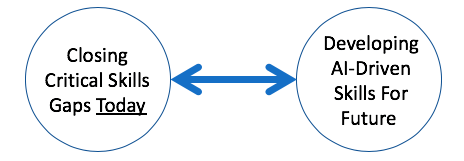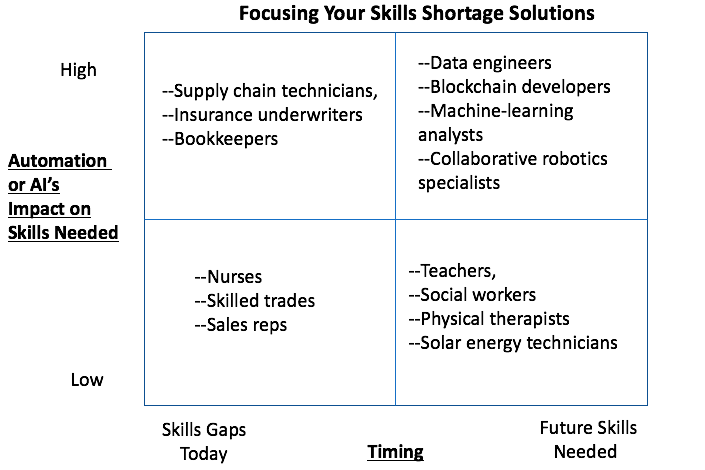
Skills gaps, workforce strategies, talent management, the future of work – This problem of finding, developing and retaining talent is nuts! It can make you either numb or nauseous.
But, like most executives in midsize or smaller companies, I imagine you’re facing two problems with your workforce. Either you’re worried about how to deal with critical skill shortages today and next year. Or you’re sweating about what capabilities your employees are going to need in the future, as automation and artificial intelligence (AI) technologies increasingly impact your operations.
Want to think about these problems in a more organized way? Want to make sure you’re not missing something important? My ongoing research for solutions in dozens of industries, in advance of my keynote talks, has led me to develop a comprehensive framework – think of it as a checklist – that you can use to organize and evaluate your executive team’s approach to workforce threats facing your business.
This is the first of four posts to layout the framework. If I made it one long post you wouldn’t read it!
Stage One… The Problem

Decide which “skills gap” problem you’re focused on
The first step is to be explicit about which “skills problem” you’re working on – short term or long term. There’s no right answer. Just make sure your team is aligned on its priorities. (Of course, it may be some combination of both.) Then evaluate the solutions you’re investing in and the process needed to “move the needle” on these challenges, as consultants love to say.
Lots of executives in middle market firms have grown numb to the “skills gap” problem. But being used to this pain doesn’t mean it’s going away, nor is it costing your business any less. Most companies need to keep the pressure on when it comes to diagnosing and tackling their most costly short term skill shortages.
But, increasingly, executives are also trying to figure out how to reinvent the skill sets their workers will need to leverage new automation and AI technologies that are key to the future of their business. Most leaders, in my experience, have no clue how to think about solutions for future skills needed.
Practical answers for this problem is a central focus of my next book: Building Tomorrow’s Workforce in Today’s Economy. One of the first lessons I’ve learned is the importance of focusing on which tasks – not which jobs – will be automated. That’s because in most cases technology will replace or supplement human skills, but not completely replace them.
Is it Today’s or Tomorrow’s Skills?
So the first step is to clarify whether you are trying to tackle current or future skill issues. And decide whether your most critical roles will be heavily affected by automation or AI. (See the matrix below).

Then ask your leadership team three questions:
- Are your current (or future) skill shortages a problem you’re trying to fix to get back to previous levels of performance? Or do you need to reinvent or design new roles to actually improve performance? My old mentor Alan Weiss makes a powerful distinction between problem solving and innovation. Some skill shortages are so severe that firms need to completely rethink jobs or skill acquisition processes? Are you just fixing a problem or innovating? Your perspective has a great impact on your search for solutions.
- Are you making well founded assumptions about how much technology is going to affect specific roles in your company? Some roles most affected include computer programmers, financial advisors, economists and detectives. Who would have guessed the last two? Are you doing enough research on the competition and the latest trends in AI and automation to not be blindsided?
- Are you just looking for solutions to current or future skill shortages, when you should be looking at these workforce challenges more as an opportunity? Today, most managers are still asking, “How do we do a better job of recruiting and retaining talent?”
But complexity experts Berger & Johnston argue we need to be posing different questions to generate more innovative solutions to complex problems. For example, what if skill shortages are an opportunity to do something radically different with your workforce and business? What could that look like?
Developing the workforce you need – today and in the future – is going to take a lot of decisions and resources. Before you start exploring or evaluating solutions (see my next post), it’s essential to make sure your leadership team is aligned on the problems you’re solving.
Contact me if you want to explore in more depth a process for clarifying your most critical talent risks, or if you’re looking for an engaging keynote speaker for your next meeting.
